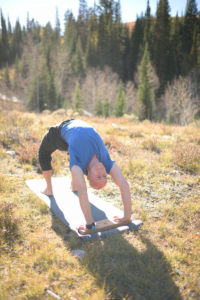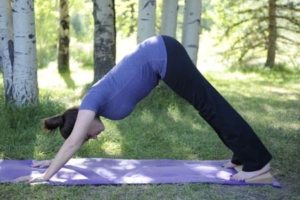 Whether you practice Hatha, Vinyasa or Kundalini yoga, at times your hands and wrists will be called upon to bear your weight. Some poses require more bendiness in the wrists and ankles than is healthy for most people. A Cork Wedge can give you the support you need to keep your wrists and ankles safe and healthy.
Whether you practice Hatha, Vinyasa or Kundalini yoga, at times your hands and wrists will be called upon to bear your weight. Some poses require more bendiness in the wrists and ankles than is healthy for most people. A Cork Wedge can give you the support you need to keep your wrists and ankles safe and healthy.
Truth is, our hands and wrists are not really designed to support our body weight, at least not repeatedly or for long periods of time. Our hands and wrists are actually very complicated, comprised of small, delicate bones, ligaments and tendons. They are designed for fine work. A properly placed yoga wedge can help prevent collapsing our body weight into our wrists so that we can continue to use our hands in the ways they were designed to work.
A yoga wedge can also keep wrists and ankles from bending further than they are designed to. There are as many variations in wrist and ankle mobility as there are people. When your joints tend to be stable rather than über-bendy, a yoga wedge can help you enjoy greater grounding and opening in certain poses.
Because Hugger Mugger’s Cork Wedge features maximum stability, sustainable materials and a nonskid surface, it’s a favorite in our yoga community. A bit heavier than our ultra-lightweight Foam Wedges, the Cork Wedge has a solid surface with less give.
Use a Cork Wedge in These Three Poses
 Downward-Facing Dog: In Downward-Facing Dog, we often collapse the weight of our entire torso down into the wrist joints. Spreading the fingers and making sure the palms are grounding evenly can help, but using a wedge teaches us how to distribute weight throughout the hand. Here’s a post explaining how this works.
Downward-Facing Dog: In Downward-Facing Dog, we often collapse the weight of our entire torso down into the wrist joints. Spreading the fingers and making sure the palms are grounding evenly can help, but using a wedge teaches us how to distribute weight throughout the hand. Here’s a post explaining how this works.
Upward Bow: A wedge can make the difference between a free and easy Upward Bow and possibly not practicing it at all. If your wrist joints don’t extend to 90 degrees, Upward Bow will always be a struggle. Placing a wedge under your hands can free your wrists, elbows and shoulders, allowing for a free and even easy Upward Bow. Here’s a post explaining how to use a wedge in Upward Bow.
Squatting: Like your wrists—and all the other joints in your body—your ankles may or may not bend past 90 degrees. If your heels don’t touch the floor in squatting position, it’s probably not a matter of soft tissue inflexibility. It’s likely that your ankle joints are constructed to limit movement past 90 degrees. Placing a Cork Wedge under your heels allows you to ground your feet evenly, making the pose stable and relaxed.
A Cork Wedge is a lightweight, easy-to-transport yoga tool that can make the difference between struggling in your practice and feeling at ease. If you’ve found other uses for our Cork Wedges we’d love to hear what you’ve learned!
